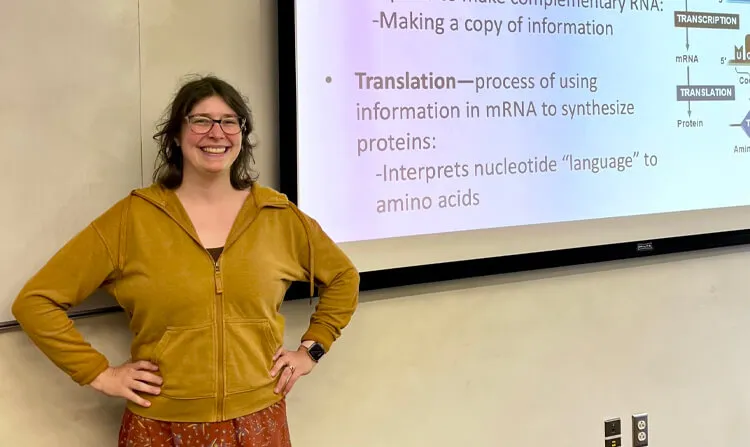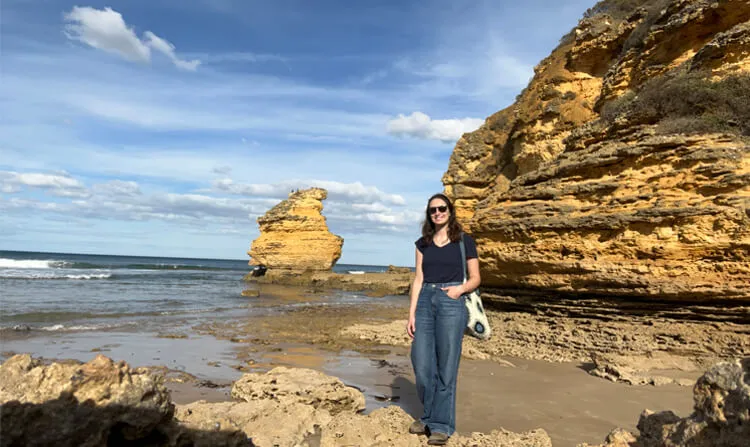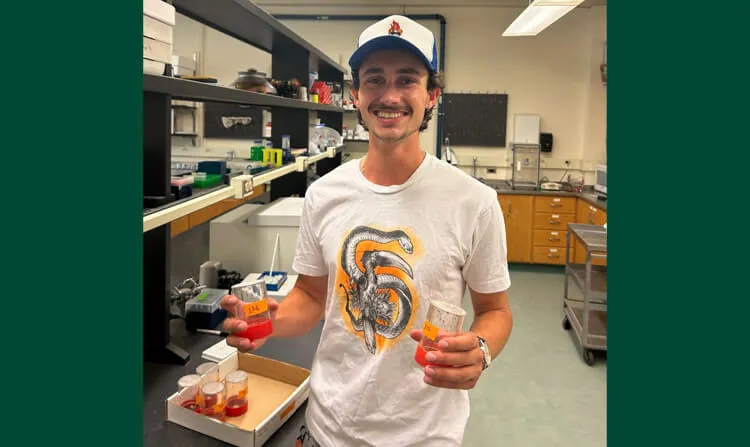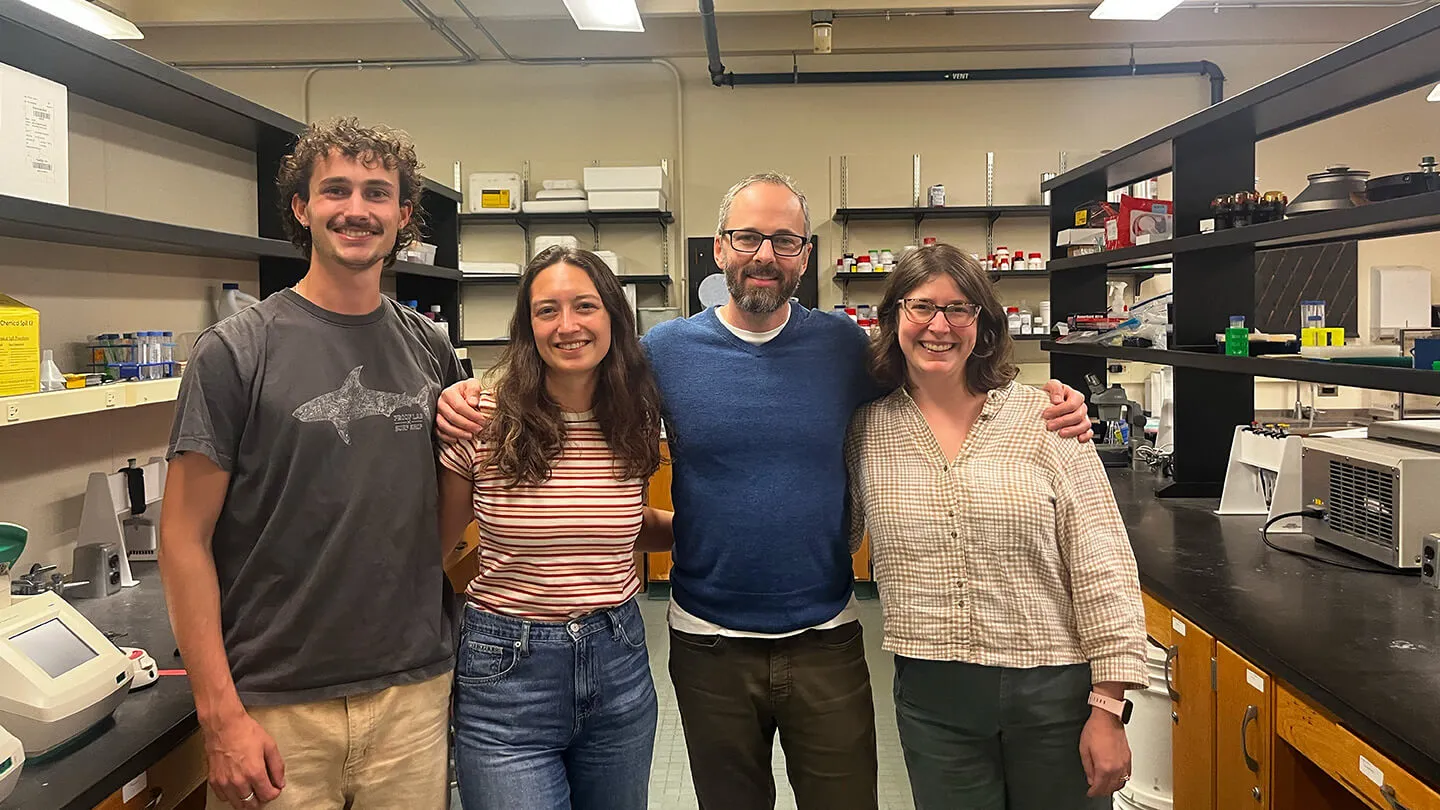A high school teacher, data scientist, research technician, or medical school student wouldn’t ordinarily have much in common. However, these are all professions to emerge out of Dr. Brent Lockwood’s research lab. Newly appointed Chair to the University of Vermont Department of Biology, Dr. Lockwood has spent over a decade at UVM researching physiological mechanisms of adaptation. Like any research lab in the Biology Department, he has been a key mentor for postdoctoral fellows, graduate students, and undergraduate students with aligning research interests. Here we zoom in on Dr. Emily Mikucki, Emily Dombrowski, and Olin King, all current or former Lockwood Lab members. How did they arrive at the Lockwood Lab and where are they going next? And how is involvement in research a driver for material and conceptual discovery?
A decade at UVM is also no time at all for Dr. Emily Mikucki, who completed her Ph.D. and postdoctoral work in the Lockwood Lab and has now become a full-time lecturer in the Biology Department. Before arriving in Burlington, Dr. Mikucki took advantage of many undergraduate field work opportunities in South America, combining both research and teaching interests from the start. This culminated in an ecological physiology thesis on thermal tolerance and climate change in butterflies, which led her right to the Lockwood lab investigating the impact of climate change on overwintering physiology in Pieris rapae. Her publications reveal that the butterflies can acclimate to higher temperature by lowering their metabolic rates in response to chronic heat, suggesting the species could be resilient to winter warming. And she’s not done with research since moving into lecturing. Dr. Mikucki uses her past work to enhance her lessons. She says that “if we can give specific examples and real world applications, it really helps students to (A) better understand it and (B) realize that it's not just this idea, but it's something that people are actively researching, actively trying to understand.”

Dr. Mikucki has thrived at UVM, gaining teaching experience at almost every level as a Graduate Teaching Assistant and most notably working with Dr. Lockwood to create courses based on her research passions, like Climate Change Genetics and Seasonal Biology. She notes that student engagement, through both research and lecturing, has been one of the greatest rewards of her career path. “That is something that I have always loved,” Dr. Mikucki mentioned, “mentoring and helping the next generation of scientists figure out what they want to do next”. She asks students to think about where they want to be in 5, 10, and 20 years. Find someone who fits that ideal and see how they got there. After all, as an undergraduate, Dr. Mikucki’s mentor and idol was a university Physiology Professor . . . a position she has found her way to, using the Lockwood Lab to get her there.
For Emily Dombrowski, a graduate advisee in the Lockwood Lab, getting involved in research was not on her radar. As Emily said, “I always thought research was like unpaid labor. I had a really negative perception of it”. But a mentor at the College of Charleston sparked her curiosity in the specificity of climate change through the physiology of a parasite affecting muscle movement in spotted trout. Growing up with her mom as an amateur environmentalist, she garnered an interest in conservation at a young age, but Emily explained that “climate change was always something that was broad and affecting everything, and super difficult to put your finger on. But this was one parasite in one species and a distinct molecular process”. This change in perspective launched a journey that would lead her to a multifaceted graduate dissertation in the Lockwood Lab, understanding how genetic and spatial variation are affecting physiological processes in invertebrates, made possible by the NSF Graduate Research Fellowship Program. Emily’s working with fruit flies, sea scallops, and invasive Australian mussels, where she spent her summer across the globe collecting mussels from the field, reproducing them in the lab, raising the larvae at different temperatures, and extracting their DNA to analyze the effect of climate change on the viable offspring produced from a native and invasive mussel cross.

Emily’s interested in transitioning into applied research, at an organization like the NOAA, where she can focus on community-oriented projects that are important to the common taxpayer. But Emily’s working to build communities here, too, through her current outreach project; setting up a mentorship component to UVM Firsts, connecting first generation undergraduate students at UVM to first generation graduate students like her. It’s that community that Emily found in Burlington that has made working in a UVM research lab so special. She mentions her fellow graduate students and lab partners as influential members of her experience, people who will be with her long after her dissertation is finished.
As an undergraduate, it was a class that led Olin King to the lab bench, co-advised by both Dr. Lockwood and Dr. Joaquin Nunez. Comparative Physiology, a course required for biological science majors like Olin, and recently taught by Dr. Lockwood, served as a capstone class that connected concepts of physiology, ecology, and evolution in a way that inspired Olin to personally ask about availability in the Lockwood Lab. That was Fall 2024. Since then, he has been working with “fiery flies”; heat treating Drosophila melanogaster embryos to uncover specific alleles that aid in thermal tolerance. They’ve found two alleles that definitively elevated embryonic thermal tolerance in tropical species, which is what Olin will be continuing to study for his senior thesis.

Awarded the SURF Grant this summer, Olin was a paid undergraduate researcher on this project and due to his contributions, an author on the paper that has been submitted to both PNAS and Science, a major achievement highlighting the serendipity of lab involvement. Olin doesn’t know where this research will take him. A Ph.D track, Master’s degree, or potentially an applied bioengineering position? But in any direction, he’s taking a wealth of knowledge and skills he’s learned from his undergraduate research position. “It's an invaluable experience to get involved in”, Olin expressed, “I immediately noticed myself just getting a better grasp around the biological aspects which I was studying in lecture, and it really drew me into my degree a lot more, and in general has been a very enriching experience to my degree.”
Dr. Lockwood was praised by all three interviewees, expressing their gratitude for a mentor that challenges and encourages their analyses, and for running a lab that acts as a hub of intellectual activity and progress. When asked about his mentorship mentality and leadership role for so many individuals on their pathway to discovery, Dr. Lockwood said, “I just try to be supportive, show compassion, and not get in the way. Learning to be an independent scientist can be intimidating—it certainly was for me—and we all respond differently to that challenge. My best mentors had diverse mentoring styles, but the common thread among them was the belief that I hadn’t yet realized my full potential. That’s the belief I carry forward.”
So, how might you become a researcher and where will it take you?
